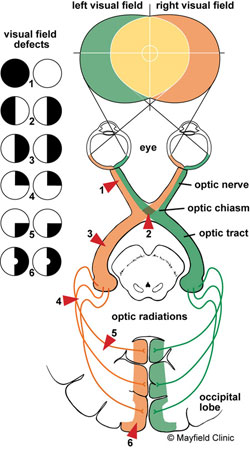-
In optometry and ophthalmology a visual field test is used to determine whether the visual field is affected by diseases that cause local scotoma (glaucoma) or a more extensive loss of vision (brain lesion) or even a reduction in sensitivity (threshold).
The normal human visual fields – Our side vision extends to approximately 60 degrees nasally (toward the nose, or inward) from the vertical meridian in each eye, to 100 degrees temporally (away from the nose, or outwards) from the vertical meridian, and approximately 60 degrees above and 75 below the horizontal meridian. In the United Kingdom, the minimum field requirement for driving is 60 degrees either side of the vertical meridian, and 20 degrees above and below horizontal. The macula corresponds to the central 13 degrees of the visual field; the fovea to the central 3 degrees.
Paris with a normal visual field

The visual field is measured by perimetry. This may be kinetic, where points of light are moved inwards until the observer sees them, or static, where points of light are flashed onto a white screen and the observer is asked to press a button if he or she sees it. The most common perimeter used is the automated Medmont or Humphrey Field Analyser and Heidelberg Edge Perimeter.
In humans, confrontational testing and other forms of perimetry are used to detect and measure visual field loss. Different neurological difficulties cause characteristic forms of visual disturbances, including hemianopsias (bi-nasal hemi-anopia shown below without macular sparing), quadrantanopsia, and others
Paris with an Optic Chiasm visual field defect – leasion 2 on the chart below

In humans, confrontational testing and other forms of perimetry are used to detect and measure visual field loss. Different neurological difficulties cause characteristic forms of visual disturbances, including hemianopsias (shown below without macular sparing), quadrantanopsia, and others.

This is a Huge Topic and we will add more
Location & Contact Details
© 2017 - 2025 Noel Templeton Optometrists



